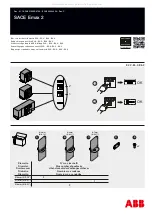
23
SECTION 15—Renewal Parts
It is recommended that sufficient renewal parts be carried in
stock to enable the prompt replacement of any worn, broken
or damaged parts. A stock of such parts minimizes service
interruptions caused by breakdowns, and saves time and
expense. When continuous operation is a primary
consideration, more renewal parts should be carried, the
amount depending upon the severity of the service and the
time required to secure replacements.
Renewal parts which are furnished may not be identical to the
original parts, but they will be interchangeable.
Renewal Part numbers are available from your local GE Sales
office.
15.1—Ordering Instructions
1. Always specify the complete nameplate data of both the
breaker and mechanism.
2. Specify the quantity, catalog number (if listed), reference
number (if listed), and description of each part ordered,
and the parts bulletin number.
3. Standard hardware, such as screws, bolts, nuts, washer,
etc., should be purchased locally.
SECTION 16—Mechanical Adjustments
16.1—General
The ML-20 Mechanism has been designed for extended
intervals between maintenance. In most cases only the wipe
and gap adjustments will require re-setting throughout the life
of the circuit breaker.
16.2—Wipe Adjustment
Wipe is the additional compression of a preloaded spring,
used to apply force to the vacuum interrupter contacts and
to provide opening kick-off force.
The contact wipe adjustment should always be made before
making the contact gap adjustment.
ML-20 The wipe measurement is made with the breaker
closed and the closing spring gagged. Measure with a feeler
gauge the distance between the bellville washer and the
trunion between the bell cranks arms. Adjustment is not
required if wipe is more than 0.100 inch. After adjustment the
wipe should be 0.160 – 0.185 inch.
To adjust the primary contact wipe, close the breaker and
proceed as follows:
1. Loosen, but do not remove, the two capscrews (9, Figure
8) holding the interrupter clamp.
2. Check that the interrupter clamp is loose. A light pry at
the clamp half-junction may be required to loosen the
wedging action of the clamp.
3. Hold the hexagon projection (6, Figure 6) at the bottom
of the operating rod insulator (1 inch wrench) and loosen
the adjacent locknut (3/4 inch wrench). (Refer to 4,
Figure 6). Adjust by rotating the operating rod insulator.
The thread is 1/2-13 and each turn will give about 0.076
inch change in primary wipe. Screw the operating rod
insulator toward the interrupter to increase wipe.
4. After setting the contact wipe on each phase, torque the
operating rod locknut (4, Figure 6) to 40-50 pounds/foot
while holding the hex projection (6) to prevent the
operating rod insulator (7) from turning. Tighten the
clamp screws (9) to 8-10 pounds/foot and trip the breaker
open. This procedure prevents accidental twisting of the
interrupter’s operating rod by loading the contacts with
the wipe springs and forcing relative rotation to occur at
the clamp interface.
After adjustment, remeasure the wipe dimensions. If the wipe
settings are within the required limits, there is an adequate
contact closing relationship between the poles.
16.3—Contact Gap Adjustment
The gap adjustment refers to the separation, or gap, between
the primary contacts within the vacuum interrupter. Before
attempting to measure or set the gap adjustment, verify that
the wipe settings are within acceptable limits. Any change of
the wipe settings will affect the gap settings.
1. Adjust the center phases first. The contact gap must be
0.595 – 0.655. The adjustment of the outer phases
affects the center phase measurement. With the breaker
in the open position and the closing spring discharged,
locate the gap adjusting nuts on the opening spring rods
connected to the outer phase bell cranks (Figure 12).
Loosen the jam nut on both rods. Back off the adjusting
bolt on the center phase VI stop (Figure 12).
2. Advance or retard the adjusting nuts depending on which
way you want to change the gap. Move both nuts the
same amount.
3. Lock the jam nuts after setting the adjusting nuts.
Operate the breaker a few times and remeasure the gap
following the procedure described in DIMENSIONAL
CHECKS, item 3.
4. Readjust the center phase VI stop (Figure 12). Set
adjusting screw for no clearance between stop and wipe
spring rod striker with the breaker open.
After adjustment of the left and right phase, remeasure the
center phase. The center phase should not exceed 0.655 inch.
If it does then readjust the left and right phases.
16.4—Trip Coil Plunger
To adjust trip coil plunger gap (Figure 9), lift locktab away
from adjusting nut. Turn adjusting nut until trip pin makes
contact with trip arm while maintaining dimension T. Bend
locktab to secure adjusting nut.
Содержание PowerVac
Страница 1: ...DEH 40368 Instructions g PowerVac Vacuum Circuit Breaker with ML 20 Mechanism ...
Страница 13: ...13 Figure 10 Control switches LCS Switch ...
Страница 26: ...26 Figure 14 Continued C Breaker closed spring discharged D Breaker closed spring charged ...
Страница 28: ...28 Figure 15 Continued Partial View A Partial View B Partial View C Partial View D Partial View D ...
Страница 29: ...29 Figure 16 Typical wiring diagram for ML 20 mechanism ...
Страница 31: ...31 Figure 19 Trip coil and linkage 1 Trip coil 2 Closing spring 3 Trip linkage adjusting rod and nut 3 1 2 ...
Страница 39: ...Intentionally Left Blank ...








































